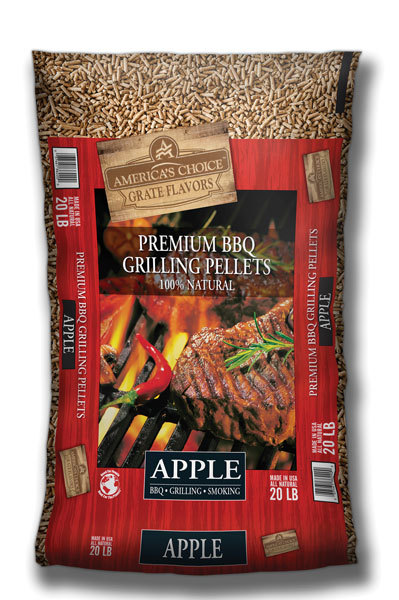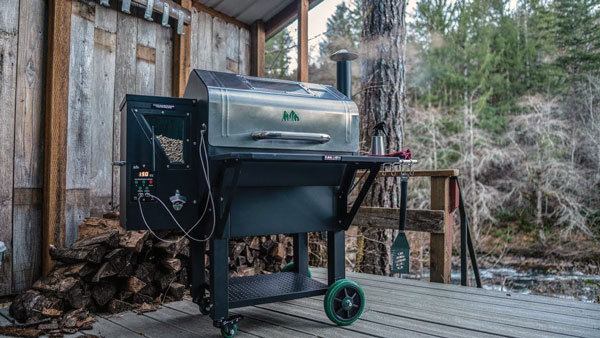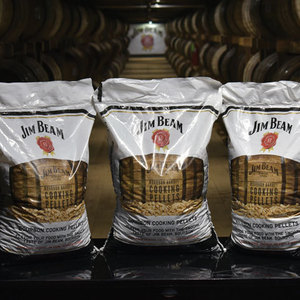Blending Passion with Flavor










PHOTO: ENERGEX INC.
September 6, 2019
BY Anna Simet
After the “high wine” production process at the Jim Beam distillery in Clermont, Kentucky, it’s tapped into 52-gallon American White Oak barrels and left to rest. As the seasons change, according to the bourbon maker, Kentucky’s climate expands and contracts the barrel, allowing it to seep into the wood and extract the caramelized sugars and oak flavor, for a minimum of four years.
When the final product is removed from the barrels, they are not reused to age bourbon, but are sourced by breweries and wineries, repurposed by specialty furniture markers, or—if any of the boards are cracked or damaged—they are shipped north to Pennsylvania, to Energex’s wood pellet manufacturing plant. There, the stays, or barrel planks, are protected from the elements until it’s time to turn them into grilling pellets. “Being bourbon drinkers and lover of Jim Beam, we reached out to them to find out what they did with their spent barrels and steam of materials,” says Kenny Lisle, Energex business development manager.. “Turns out that they have a large supply of unusable barrel pieces—thousands of tons of barrel stays in their inventory. We secured a licensing agreement them and began taking shipments directly from Kentucky.”
While Energex’s Mifflintown, Pennsylvania, plant has been making fuel pellets since 2000, the company began experimenting with grilling pellets a few years ago, Lisle says. “We didn’t think there were a lot of options in our area, and we found some brands that would say hickory on the bag in bold letters, but then 100 percent hardwood at the bottom. Eventually, we learned how small the percentage of the wood species were actually in them—most had the same filler wood, and just trace amounts of the wood they were advertising.”
Wanting to make a genuine, authentic brand, Energex began with 100 percent hickory, and besides its Jim Beam pellets, added 100 percent apple. “Here in Pennsylvania, we got hooked up with an orchard that wanted to tear down, so we chipped it all up on-site, and hauled it to our plant to make grilling pellets.”
Growth of the grilling pellet industry of the past few years has been momentous, with some pellet and grill manufacturers reporting triple-digit growth, but jumping into the game isn’t as easy as it might seem, Lisle points out. “It’s definitely a different world than heating pellets.”
Grilling vs. Heating
Despite perceptions that they are quite similar, grilling and heating pellets have many preparation, production and market differences. “First, we’re a lot more careful making barbeque pellets, and there are certain lubricants we require to made food grade wood pellets,” Lisle says.
Fiber storage is also different. “We really only run the Jim Beam material whenever there isn’t rain—when we chip it, we need to make sure it stays dry and isn’t saturated with water, as we want the bourbon in the wood to remain as pure as possible. It can’t be out in the weather.”
A fuel pellet producer might receive materials from hundreds of suppliers with a main requirement of ash content and hardwood species, but for grilling pellets, it is much more specific, and that could becoming even more challenging in difficult times for the fiber supply market. “Coming off a year where we saw the Mid-Atlantic wood shortage—we couldn’t get any wood to make heating pellets—for most of the winter, we were sitting on a higher inventory of tonnage of Jim Beam barrel pieces than material to make heating pellets,” Lisle says. “When you’re looking for specific wood species and going outside of your territory, it creates a new challenge than you’re used to.”
Besides storage and having to segregate wood species, says Stephen Faehner, president of American Wood Fibers, time in the production schedule must be set aside to functionally feed and control the grilling pellet process. “Some do this in a very rough way, but we do it in a very controlled, blended way, and it takes more equipment to do that,” he says. American Wood Fibers makes fuel and grilling pellets at its Ohio and Virginia plants, beginning production in 2005 and 2013, respectively. Its grilling pellet brand, America’s Choice Grate Flavors, includes flavors mesquite, apple, hickory and a hickory, maple, and oak blend.
There is a challenge in manufacturing when minor ingredients and different woods are introduced, Faehner says. “How you manage all that, there is an art and trick to it, as well as controlling the manufacturing process and delivering on your product features and claims—are you really putting in the right percentage? There are challenges to it all.”
There are also logistics differences when it comes to shipping product—the customer radius of grilling pellets can extend far beyond that of heating pellets, and still be economical. “We’re going from heating pellets being fairly regional to national, and some cases, it’s international,” Lisle says. “We get requests all the time from outside the country for cooking pellets. There is that element with some of the heating pellet market—the export market—but in this situation, everything is just in a lot smaller quantities. We can ship to California, all of the West Coast, and in the past with heating pellets, that’s not something we could even come close to. If you’re shipping a user of barbeque pellets a bag or two across the country, they might have a dollar or two in logistics costs, but on a heating pellet, buying two or three tons, they could spend $100 on freight themselves.”
As for margins, it’s difficult to put into numbers as several variables come into play. “Fuel pellets are a feast or famine margin,” Faehner says. “There are some good years, there are some bad years, and sometimes, trying to find the margin is tricky. Barbeque pellets have potential for a better margin, but they are tricky to make—to get the right blends takes a good bit of expertise and equipment, and you really have to know what you’re doing. Can you get a better cost for them? Yes. A better margin? Hopefully, but again, you have to know what you’re doing or you will spend all your time switching your formulas, and cleaning, resetting and starting up again.”
The margins are definitely higher, but maybe not as high as people think, Lisle says. “If you’re an existing heating pellet manufacturer, you can go one of two ways, possibly both—copacking for the big guys, or developing your own brand. Copacking may be easier—you don’t need to develop a marketing strategy for a new brand—but the margins are way less.”
The other strategy is brand development, which Lisle says might have a more profitable outcome, but requires much more time and investment. “There are a lot of upfront costs, you need to developing your own packaging bags, brand, trademark—so there is an added cost; it’s not as easy as everyone thinks—you have to be committed if you want to do it. I have walked into many retail stores and told them we are a heating pellet manufacturer but have started making cooking pellets, and they think they’re the same thing and we’re just looking to make more money.”
The strong growth and demand for grilling pellets is the direct result of more grills sold, a technology that is commonly referenced as one that once consumers try it, they are hooked.
Market Dynamics
“I don’t want to say pellet grilling technology is flawless, because it has its quirks, but if you want really good grilled food—even if you think you don’t really know what you’re doing, the wood pellet grill makes you a barbeque master,” Faehner says. “I have done turkeys for Thanksgiving, salmon for Mother’s Day, briskets for birthdays—there is a theme here—it’s year-round.”
Those in the pellet grill business have been busy. “They’re selling grills faster than they can make them,” Lisle says. “A lot of pellet grill manufacturers are sold out. They wait on ships that come in from overseas, and the containers are gone as soon as they arrive. That definitely speaks to the growth.”
Green Mountain Grills’ products are some of the fast-selling models Lisle refers to—the company, which released its first edition in 2008, has only 30 employees in the U.S., but is on a well-known name among manufacturers. GMG also manufactures several blends of grilling pellets—the side of its business on which the company initially had a primary focus. “We have added lots of models and pellet blends over the years,” says Jason Baker, GMG business development. “As the company and market grew, people began wanting lots of different flavors of pellets, and there has been lots of clever marketing toward certain pellet flavors for certain foods.”
As for its grills, which are manufactured overseas, the most significant innovation GMG integrated into its designs, says Baker, is a WiFi chip. “We were the first to put it on pellet grills and make it mainstream—we kind of perfected it from an app perspective, being the first to run it through iOS and Android,” he says. It’s been a differentiator for us, and flattering to see so many emulate that. We knew it was a good strategy to start with. The side of innovation is where we live—the customers are always asking for new and better, and we try to deliver that. We spend a lot of time engineering what’s next, and we’re focused on what we’re doing tomorrow.”
Demand has been strong and steady, Baker says, but as a small company, it is difficult to parallel the market’s explosive growth. “We’re very comfortable in the sense that we can only grow so much,” he says. “Even though we’ve seen situations where we could have been up 50 percent, we just don’t have the investment strategy to accomplish that.”
As for the biggest challenge, Baker says it’s being priced out by those supplying to big box stores like Wal-Mart and Amazon, as the company has a business model of only doing business with brick and mortar retailers. “Our business model is different than a lot of folks—we sell through a dealer network,” he says. “They have the overhead and the knowledge. Unfortunately, customers are very comfortable pushing a button and getting it at the door. It’s a challenge, and though we don’t want to make a relationship with Amazon to compete, one day we may have to. We’ll all have to figure it out one of these days.”
A potential leg up brick and mortars may have over big box stores is that most large retailers are seasonally driven, and in many regions—even ones with harsher winters—grilling is almost year-round. “There are maybe a couple of months in the year that I’m not grilling,” says Faehner. “One of the challenges is getting more retailers to carry through the year, and not do the seasonal in and out thing they do with heating pellets. I see it as a year-round product—I think that’s part of the power of the technology.”
That year-round quality could also mean pellet manufacturers are running at times when heating pellets aren’t being made, thus softening the blow of off years. “If you’re having a warm winter, during those months of January through March, you can start gearing up for the barbeque market,” Lisle says. “The timing works pretty well. Is it going to take up your entire production facility as far as volume? No, probably not. But it will help financially, help keeps people employed, minimizes layoffs and help ease those off years. We haven’t been in that position yet though, as we haven’t had a weak pellet heating business since we have been making them.”
Consumers are slowly pulling away from gas, Lisle adds. “With [gas grills], you burn it until it tastes good. I couldn’t tell the difference having a burger from a gas grill, then I started cooking with pellets. Years went by, and I went to a cookout where a gas grill was being used, and I could taste the propane. Even if I leave the pellet business, I’m never moving away from a pellet grill. There’s nothing like cooking over wood fire.”
Author: Anna Simet
Editor, Biomass Magazine
701-738-4961
asimet@bbiinternational.com
Advertisement
Advertisement
Advertisement
Advertisement
Upcoming Events





